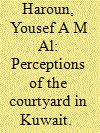| Srl | Item |
| 1 |
ID:
192269


|
|
|
|
|
| Summary/Abstract |
This article examines the privacy, sociality and conviviality dynamics of urban khans in Ottoman Istanbul from the mid-eighteenth to the mid-nineteenth centuries. Firstly, it looks at the professional and ethno-religious patterns in their use as commercial and residential spaces, then discusses khans as a private residential space, through inheritance records of those who live and die in a khan room. Finally, it turns to issues regarding the public spaces of a khan, namely its common areas, and in particular performative and theatrical practices located in khan courtyards. The article highlights the particular role played by urban khans as convivial spaces of residence, artisanal production, commercial exchange, and sociability.
|
|
|
|
|
|
|
|
|
|
|
|
|
|
|
|
| 2 |
ID:
172439


|
|
|
|
|
| Summary/Abstract |
The courtyard was once found in every house in Kuwait. It was a multi-purpose open space where the entire family would gather and socialize. Some courtyards had a tree or shrub, and most would have a well. This all changed after the discovery of oil. In the 1950s Kuwait underwent rapid and unprecedented urbanization and within a decade was transformed from a small shaikhdom to a modern regional metropolis. Kuwaitis were forced into a new lifestyle. The Kuwaiti house changed from the courtyard house, sustainable, private and inward-facing, into the modern villa, full of new technology, and facing outward toward the street. In this study, the courtyard is used as a vehicle to examine a number of socio-cultural, economic and political aspects of the move towards modernity in the domestic built environment and away from the vernacular and sustainability. Investigating several questions that have been raised in prior research, this study aims to identify the qualities and uses of the courtyards that people might value and use in the contemporary house. A mixed-method approach has been employed to provide qualitative data to support and complement quantitative findings. The article’s ultimate aim is to add to our understanding of how how people have dealt with and adapted to the collision between traditional concepts and modernity. Among the findings is the existence of a surprising disconnect between past realities and current perceptions, even about what a courtyard is.
|
|
|
|
|
|
|
|
|
|
|
|
|
|
|
|